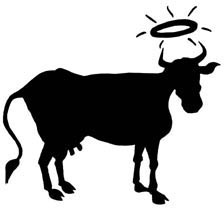To my father, who gave me a sense of humor.
To my mother, who taught me how to think.
To the entire Bernstein family.
To my father.

I n the Rigveda, one of the four most holy Hindu texts and the oldest of all religious books, it is written that Cows are sacred. Man, if we had a nickel for every time we started a sentence with In the Rigveda, we would be very wealthy guys. As it is, only one of us is wealthy and thats because his uncle invented Silly String.
At this juncture we feel it prudent to point out that Silly String was actually invented by Julius Smann (who also invented pine treeshaped air fresheners). Mr. Smann is not related to any one of us (as far as we know). We admit this because its important to establish a sense of trust between the author and the reader. Also you could have Googled Silly String and busted us anyway.
The important thing to remember here is not so much that were liars, but that Sacred Cows have been roaming among us since around 1,700 BC . And, as George Foreman has proved time and time again, old things die hard.
So, what is a Sacred Cow? Or, as they say in Grenoble, Quest-ce que cest une Vache Sacr? (We cant wait to see how they treat those last two sentences when they translate this book into French.) In the Hindu tradition, the Sacred Cow is an honored figure that represents the bounty of the earth, a mothers love, and the sanctity of life. In the world of commerce, the Sacred Cow is a saying, motto, or aphorism about how business should be conducted that is widely assumed to be unassailably true.
This book is not about Hinduism, Indian Sacred Cows, fat boxers, or Swiss novelty inventors. This is a book about business. And the Sacred Cows to which we refer do not wander through the Indus Valley munching on subcontinental grasses and grains. The Sacred Cows that we plan on killing are pithy edicts repeated and sanctified and followed blindly by employees and management throughout the world.
Theyre a set of words, rules, or actions that businesspeople believe in primarily because businesspeople have always believed in them, so why stop now? These Cows have been passed down from generation to generation like creepy family heirlooms that ought to embarrass you but in which you take tremendous albeit incomprehensible pride. You know, like that picture of your great-grandfather dressed as a hula dancer. That shouldnt be on the mantelpiece. Who cares if he was a Navy captain crossing the equator for the first time? That photo should be kept in a dank, dark vault somewhere only to be used in extreme cases of blackmail.
The Sacred Cows of the business worldthose phrases that everyone believes in without really bothering to analyzeall have worthwhile elements. At some point they made a lot of sense and had real value. Even though they have outlived their usefulness, they stubbornly stay in place as businesses, companies, employees, competitions, and cultures evolve around them. As time passes, they become the one unchangeable business constant remaking everything else in their image. You end up adapting your business to suit a philosophy instead of adapting your philosophy to suit your business.
Theres nothing wrong with developing a philosophy based on a careful study of prior successes. A crafty businessman will look at a functioning concern and say, This works and it has these properties. But theres an important distinction to be made between that analysis and the assertion that This works because it has these properties. Once you start believing in the inevitability of a perceived cause and effect, youre falling for a Sacred Cow and you could be getting yourself into trouble. McDonalds works and they sell revolting food. McDonalds doesnt work because they sell revolting food. If it did, then the old lady with the glass eye who operates the roach coach in front of our office would be a billionaire.
These constraining thoughts are usually simple and cogent. They have to be plausible to stick around for so many years. After all, crazy doesnt last too longjust look at Mike Tyson. And, while were mentioning famous heavyweights, why was Archie Moore called The Ole Mongoose? Thats a weird nickname. Maybe you could look into it while youre Googling Silly String.
When we talk about Sacred Cows, were talking about many of the fundamental tenets of commerce. A classic Sacred Cow of the ilk which we plan on destroying is The Customer Is Always Right. Who in their right minds would take issue with that statement? Well, we would. And we didyoull read about it in a few chapters.
The Customer Is Always Right is one of those archetypal catchphrases that companies latch on to and wont let go of, like a Rottweiler with a duckling clamped in its jaws. Someone in upper management announces at a board meeting that from now on their company will be dedicated to the principle that The Customer Is Always Right. And thatll be that. No one will argue. Everyone will fall into line. And the driving force behind that business will be a shallow platitude that looks good in a mission statement.
Sometimes this fervent adherence to corporate philosophy will lead to great success. There are plenty of shops out there that treat the Customer as if he or she is Always Right, and they thrive because of it. But its the blindness and lack of healthy skepticism that Sacred Cows engender that lead to trouble. Sometimes theyre right. But if you follow them without reason or flexibility, youll never know when theyre not right for a particular business transaction, product line, or situation.
Sometimes desperately servicing the primacy of the Customer can lead to a companys demise. Sometimes treating the Customer as if he or she is totally clueless is your surest route to victory. You may not believe us now, but you will once you have read this book. You may also want your money backbut thats between you and your bookstore.
We have assembled a list of some of the most widespread and beloved Sacred Cows of business. We have piled these Cows into a metaphoric killing floor in a theoretical cattle farm that is hypothetically in Montana (but definitely within 300 miles of Canada). In the ensuing pages we will wander among these lowing, ignorant beasts, striking vicious blows to their necks and shoulders with giant, razor-sharp medieval flails. We take no joy in this bloody, noisy, bone-and-cartilage-spewing slaughter. We do it as a service to humanity. Also, we got a large advance on the book, and if we dont write it, Hyperion will sue us.
The purpose of this book is not to replace old, stale Sacred Cows with newer, fresher ones. Were not going to make you watch us murder The Customer Is Always Right just to supplant it with The Customer Must Wear Toe Socks. That would defeat our purpose. It would also be insane. Our goal is to point out the inefficacy of slavishly conforming to any preconceived notions about how businesses should be run.















